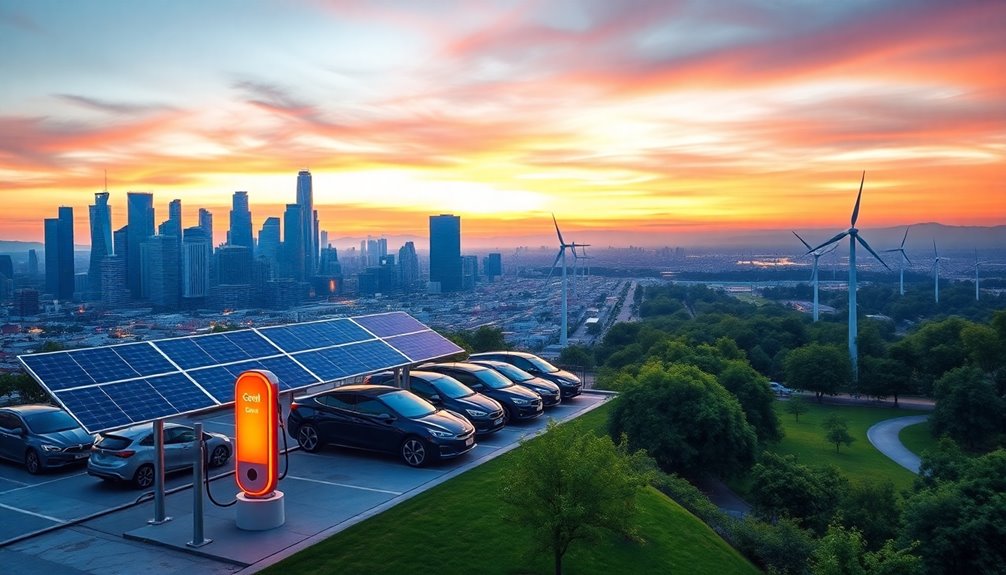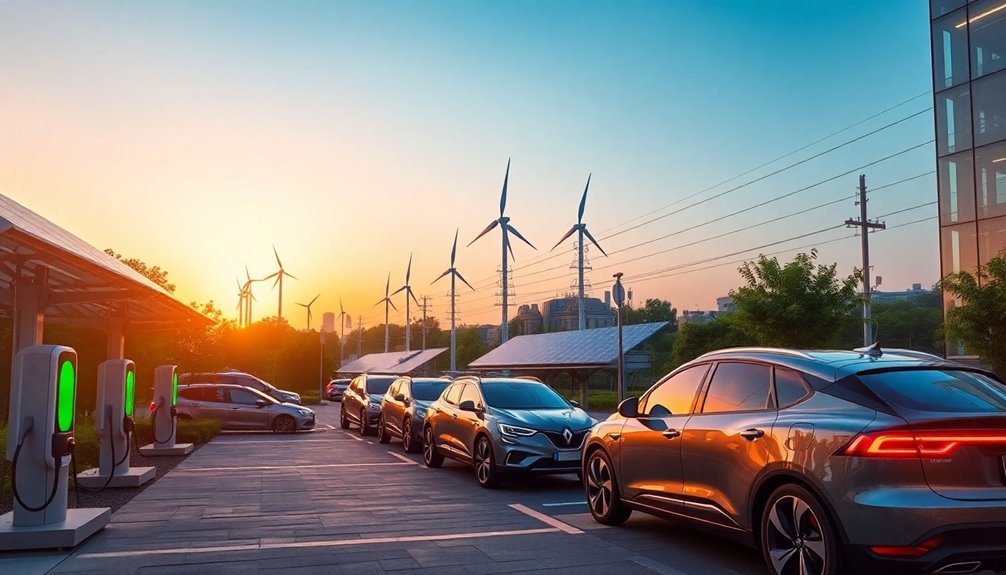To analyze future decarbonization effectively, you need to consider integrated energy systems that focus on sector coupling, life-cycle assessments, and vehicle-to-grid integration. By bridging transportation and energy, electric vehicles can reduce fossil fuel reliance while enhancing renewable energy demand. You'll also want to evaluate the full environmental impact throughout the life cycle of technologies. This holistic approach is vital to transform energy systems and drive meaningful progress. Discover more insights on this crucial topic ahead.
Key Takeaways
- Integrated energy systems enhance sector coupling, enabling efficient interactions between transportation and energy sectors to support decarbonization efforts.
- Electric vehicles (EVs) promote renewable energy demand and reduce fossil fuel reliance, necessitating robust charging infrastructure for grid resilience.
- Comprehensive life-cycle assessments of energy systems and technologies ensure sustainability by evaluating emissions from production to disposal.
- Carbon capture technologies are crucial for reducing emissions in hard-to-abate sectors, complementing renewable energy transitions and improving overall energy efficiency.
- A holistic approach that incorporates sector coupling, life-cycle impacts, and vehicle-to-grid strategies drives effective decarbonization and transforms energy systems.

As the world grapples with climate change, decarbonization and energy systems are at the forefront of the conversation. To tackle this challenge, you'll need to understand how integrated energy systems can enhance sector coupling, life-cycle assessments, and vehicle-to-grid integration. Each of these aspects plays a crucial role in reducing emissions and achieving climate goals.
Focusing on sector coupling, think about how electric vehicles (EVs) can bridge the gap between transportation and energy. By electrifying transport, you not only cut down on fossil fuel use but also create a demand for renewable energy. As you consider the necessary charging infrastructure, realize that it's vital for enhancing grid resilience. Smart charging systems can optimize energy use based on availability, ensuring that EVs contribute positively to the grid. In line with this, the U.S. must increase carbon-free electricity generation from 20% to 75% by 2030 to support widespread EV adoption.
Electric vehicles bridge transportation and energy, reducing fossil fuel use and enhancing grid resilience through smart charging systems.
Next, examine life-cycle assessments. You should assess the environmental impact of materials from extraction to disposal. For instance, understanding the full life-cycle emissions of batteries is essential for evaluating their sustainability. Consider renewable energy infrastructure, like wind turbines, and how their life-cycle analysis can inform better practices. Emphasizing a circular economy will help minimize waste and emissions, aligning perfectly with decarbonization goals.
You're also likely aware of the importance of carbon capture technologies in hard-to-abate sectors like steel and cement. These technologies are crucial for reducing emissions, complementing the shift to renewable energy sources. As you integrate these systems, remember that energy efficiency improvements can significantly reduce energy demand, further aiding decarbonization efforts.
Ultimately, integrating these perspectives enables a holistic approach to decarbonization. By considering sector coupling, life-cycle impacts, and vehicle-to-grid strategies, you can contribute to transforming energy systems. A collaborative effort across sectors will pave the way for a cleaner, more sustainable future.
Embracing these integrated strategies will empower you to tackle the climate crisis more effectively while driving innovation in energy systems.
Frequently Asked Questions
What Is Sector Coupling in Energy Systems?
Sector coupling in energy systems means integrating renewable electricity with sectors like heating, transport, and industry.
You're essentially maximizing the use of clean energy to decarbonize the economy. This approach utilizes technologies like hydrogen production and battery storage to enhance efficiency.
How Does Vehicle-To-Grid Integration Work?
Vehicle-to-grid integration works by allowing your electric vehicle (EV) to both charge and discharge electricity with the grid.
When demand peaks, your EV can supply power back, stabilizing the grid. You'll use a bidirectional charging station that communicates with the grid to manage energy flow.
This technology turns your EV battery into a mobile energy storage unit, enhancing renewable energy use while reducing greenhouse gas emissions and providing potential cost savings for you and utilities.
What Are Life-Cycle Assessments in Decarbonization?
Did you know that Life-Cycle Assessments (LCAs) can reduce greenhouse gas emissions by up to 30%?
When you explore decarbonization, LCAs help you evaluate a product's environmental impact from raw material extraction to disposal.
You gather data on inputs and outputs, assess impacts, and interpret results.
This structured approach allows you to make informed decisions, identify sustainability challenges, and choose the best pathways for implementing emerging decarbonization technologies effectively.
What Challenges Exist in Implementing Sector Coupling?
When implementing sector coupling, you'll face several challenges.
First, there's the increased electricity demand that requires significant investments in renewable energy and infrastructure.
You'll also need to tackle varying energy efficiency levels across technologies and the high costs of electrifying sectors like transport.
Additionally, existing grid infrastructure may require upgrades to handle peak loads, and managing the intermittency of renewable sources demands advanced grid management and storage solutions.
How Can Consumers Participate in Vehicle-To-Grid Programs?
Did you know that participating in vehicle-to-grid (V2G) programs can save you up to 30% on your electricity bills?
To join, you can opt for time-of-use rates, allowing you to charge your EV during off-peak hours.
Engage in demand response programs by adjusting your charging during grid stress for incentives.
With a bidirectional charger, you can even send energy back to the grid, further monetizing your EV's flexibility!
Conclusion
As we move towards a sustainable future, it's clear that integrated energy systems hold the key to effective decarbonization. By embracing sector coupling, considering life-cycle impacts, and leveraging vehicle-to-grid integration, we can tackle climate change head-on. It's time to put our cards on the table and collaborate across sectors. Together, we can create a cleaner, more resilient energy landscape that benefits everyone. The future is bright, and the path is ours to pave.








